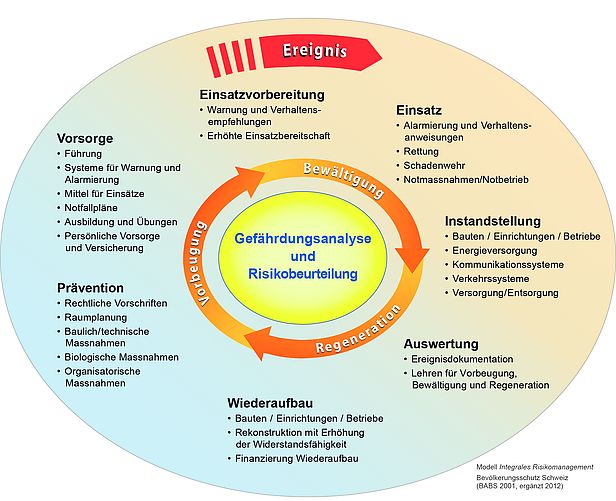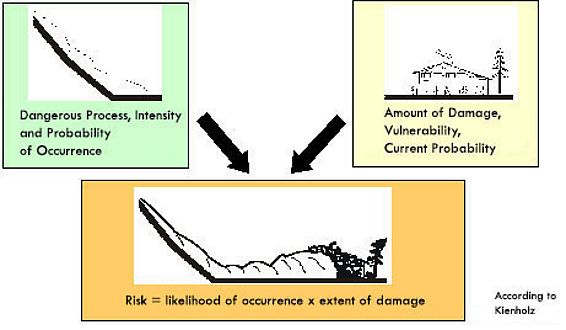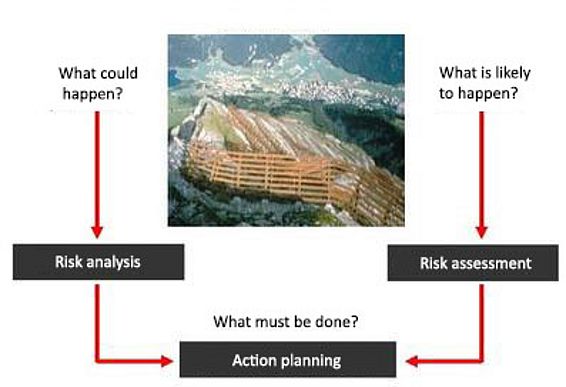Damage caused by floods, debris flows, landslides, rockfalls, avalanches, storms and earthquakes cannot be completely avoided, despite significant investments in protective measures. Absolute safety is not possible. With broad-based risk management, however, we can attempt to prevent or minimise damage.
Until the 1980s, natural hazards were addressed primarily by reacting to events and repairing damage in hazardous areas. Beginning in the 1990s, however, experts began to rethink this approach and developed the first tools for planning risk-oriented protection measures. In Switzerland, protection against natural hazards is now based on the "Risk Minimisation Concept" (risk concept) and the principles of "Integral Risk Management". Specifically, this means reducing risks to an acceptable level rather than attempting to prevent natural hazards by all available means. This risk concept has also been practiced in other sectors, such as the use of nuclear energy for civilian purposes, for some time.
Hazard and Risk – Two Often Confused Terms
An avalanche, in itself, does not pose a risk. The risk arises only when a potentially dangerous process, such as an avalanche, coincides with the vulnerability of, for example, a building or a skier to suffer damage. Ultimately, in technical jargon, risk is defined as the probability of the occurrence of a specific extent of damage (e.g. 100,000 francs) within a defined time interval (e.g. one year). This is calculated according to the following simple formula: risk = likelihood of occurrence x extent of damage.
Risks can be managed. Instead of attempting to prevent natural hazards at all costs, efforts are made to reduce the risks associated with natural hazards. Risk management involves all of the measures that make this possible. Thus, the probability of an avalanche can be significantly reduced by constructing support structures in its starting zone. Vulnerability to damage can be reduced, for example, by imposing construction bans in areas which are particularly at risk with regard to avalanches or floods. However, the risk can practically never be reduced to zero.
Integral Risk Management
Risk management encompasses all measures and methods with which a certain level of safety is to be achieved. The first step is to identify and evaluate a risk. The required action is derived from this. The Risk Concept provides a structured approach for this according to three questions:
- Risk analysis: what could happen?
- Risk assessment: what is likely to happen?
- Action planning: what must be done?
The risks are assessed from the perspective of the individual as well as from that of the community. An intensive dialogue with all stakeholders is particularly important for successful risk management. The measures can only really be successfully implemented if these people understand the measures, stand behind them, and get involved.
Risk management is integral if
- all natural hazards are considered
- all stakeholders participate in the planning and implementation of measures
- all types of measures are included
- a comparable level of safety is sought for all natural hazards
- and all aspects of sustainability are taken into account: the level of safety should be ecologically, economically and socially justifiable.
- The measures for
- prevention
- management
- and regeneration of natural hazard events
are optimally coordinated with one another.

The SLF was already intensively involved in the preparation of the risk concept for natural hazards and the guidelines for its implementation. We are also developing
risk calculation tools and decision-making tools which enable safety officers, insurance companies, authorities and other stakeholders to weigh the risks and choose appropriate protection strategies.
Risk Management for Winter Sports
Winter sports enthusiasts who practice their sports off-piste are venturing into avalanche territory. Risk management is also required for these cases: ski tourers and off-piste skiers try to achieve the greatest possible range of movement at an acceptable risk. The SLF provides the essential basis for this, such as the avalanche bulletin. In addition, it is responsible for the development of handy risk management tools, such as the graphic reduction method, the SOCIAL group check, and a tool for assessing individual slopes. These tools structure the decision-making process and aid in the proper weighing of the various factors. In cooperation with its partners in the Snow sports"Core Training Team for Avalanche Prevention in Winter Sports", the SLF is working on the continuous development of these tools and on making them accessible to the public through broadly supported teaching documents and specialist courses.
(Kopie 6)
Contact
(Kopie 1)
Links
Nationale Plattform Naturgefahren PLANAT
BAFU, Integrales Risikomanagement

